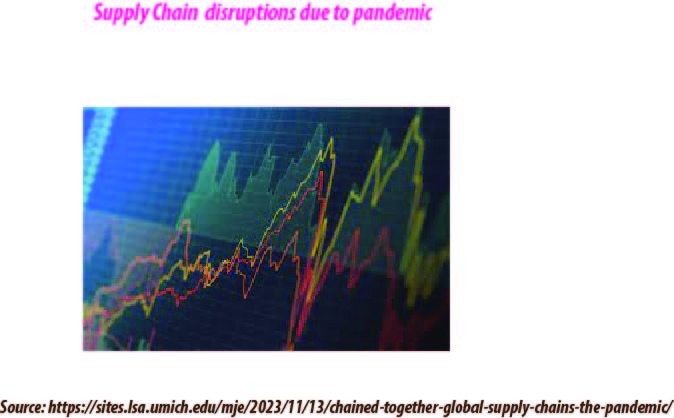Abstract
The U.S.-China trade war and the Covid-19 crisis have prompted manufacturers worldwide to reassess their supply chains, focusing on increasing domestic production, boosting employment in their home countries, reducing dependence on risky sources, and rethinking lean inventories and just-in-time replenishment strategies. The pandemic has exposed vulnerabilities in production strategies and supply chains, leading to increased political and competitive pressures. Modern products often require specialized technological skills, and manufacturers often rely on suppliers and subcontractors who focus on specific areas. However, relying on a single supplier deep in their network increases disruption risks. To mitigate these risks, manufacturers should categorize suppliers as low-, medium-, or high-risk, using metrics like revenue impact, factory recovery time, and alternate sources.
Keywords: The post Covid-19 supply chains.
Introduction
Pandemics have significantly impacted business strategies, pressure organizations to adapt and be resilient. To survive and sustain in the post COVID-19 supply chains situation, companies must emphasis on resilience, viability, real-time information, order fulfillment/just-in-time, stability, data analytics, collaboration, integration, and demand forecasting. Successful resilient SCs engage suppliers and stakeholders with open systems for sustainable performance. Implementing order fulfillment/just-in-time delivery strategies can lower costs and support the survival of supply chains.
Supply and demand shocks
The U.S.-China trade war and the supply and demand shocks brought on by the post Covid-19 supply chains crisis are forcing manufacturers everywhere to reassess their supply chains. For the foreseeable future, they will face stress to increase domestic production, raise employment in their home countries, lessen their dependence on risky sources, and rethink strategies of lean inventories and just-in-time replenishment, which can be crippling when material shortages arise.
Global supply chain
When the Covid-19 pandemic subsides, the world is going to look markedly different. The supply shock that started in China in February and the demand shock that followed as the global economy shut down exposed vulnerabilities in the production strategies and supply chains of firms just about everywhere in the post covid-19 supply chains. Temporary trade restrictions and scarcities of pharmaceuticals, critical medical supplies, and other products highlighted their weaknesses. Those developments, combined with the U.S.-China trade war, have activated a rise in economic nationalism. As a consequence of all this, manufacturers worldwide are going to be under greater political and competitive pressures to increase their domestic production, grow employment in their home countries, reduce or even eradicate their dependence on sources that are perceived as risky, and rethink their use of lean manufacturing strategies that involve minimizing the amount of inventory held in their global supply chains.
Modern products
Modern products often require specialized technological skills to create critical components or sophisticated materials. A single firm cannot produce everything by itself, as seen in the electronics content in vehicles and the creation of nucleoside phosphoramidites for DNA and RNA sequences in Covid-19 vaccines and drug therapies. Manufacturers in most industries have turned to suppliers and subcontractors who barely focus on just one area, and those specialists usually have to rely on many others. Such an arrangement offers benefits: You have a lot of flexibility in what goes into your product, and you’re able to include the latest technology. But you are left vulnerable when you depend on a single supplier somewhere deep in your network for a crucial component or material. If that supplier produces the item in only one plant or one country, your disruption risks are even higher.
Suppliers
The mapping process should categorize suppliers as low-, medium-, or high-risk, using metrics like revenue impact, factory recovery time, and alternate sources. It’s crucial to determine how long a company can endure a supply shock without shutting down and how quickly an incapacitated node can be replaced. Manufacturing capacity depends on flexibility and specialized operations, such as producing advanced smartphone chips in Taiwan, fabricating exotic sensors and constituents in countries like Japan, Germany, and the US, and refining neodymium for AirPods and electric-vehicle motors in China.
Digital supply chain
Businesses should use demand-sensing signals from consumer sentiment, integrate digital supply chains into planning, procurement, manufacturing, and logistics, and acknowledge supply chains as a crucial differentiator from rivals in order to successfully navigate the COVID-19 pandemic. Invest in digital technologies, rethink supply chain strategies for risk and resilience, and give human resources the freedom to achieve extraordinary feats. Give supply chain workers a sense of empowerment, accountability, and ownership so they can accomplish more than they previously believed was possible. Lastly, use a sustainable supply chain that is designed with the environment and circularity in mind to innovate with customers in mind. By doing this, businesses will be better equipped to handle crises in the future and seize opportunities when they arise.
Conclusion
We can say the post Covid-19 supply chain is more nationalistic than before. No manufacturer and seller can ignore China in the whole world. Modern products has multiple ingredients that need to collect from different suppliers. Post covid-19 supply chain is more digitally oriented. Companies committed to excellence in supply chain execution should be moving toward a digital strategy. McKinsey noted that there is not yet a “Toyota Way” of the digital supply chain, but 66% of supply chain professional respondents to a survey showed that implementing new technologies and capabilities was a top priority. Technology is the No. 1 area where CFOs are open to new spending, and digital supply chains can reduce costs, boost EBITDA, increase revenue, and increase customer service.
References:
- M , Luthra.Sunil , Joshi.Sudhanshu & Kumar.Anil. (2022).“Developing a framework for enhancing survivability of sustainable supply chains during and post COVID-19 pandemic”. International Journal of Logistics Research and Applications, 2022•Taylor & Francis
- Sean.Harapko.(2023). “How COVID-19 impacted supply chains and what comes next” .https://www.ey.com/en_gl/insights/supply-chain/how-covid-19-impacted-supply-chains-and-what-comes-next
- https://hbr.org/2020/09/global-supply-chains-in-a-post-pandemic-world
- https://sites.lsa.umich.edu/mje/2023/11/13/chained-together-global-supply-chains-the-pandemic/
- https://youtu.be/BUTJ1eVL_VA?si=4LRIhxOinwccVZQI
- https://rumble.com/v3yqye6-future-proof-your-business-resilient-post-covid-19-supply-chains.html





